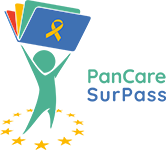
Thanks to better cancer treatments, more than 80% of children and adolescents in in Europe who get cancer will now survive more than 5 years. It’s estimated there are currently more than 500,000 survivors of childhood and adolescent cancer across Europe, and this number is growing. But cancer treatments are harsh and there are long-term affects that mean that survivors require closer health monitoring than the average population. There are clinical guidelines that tell healthcare professionals what care is needed, but it’s challenging to put them into practice in routine survivorship care. The digital Survivorship Passport (SurPass) can help!
PanCareSurPass is an EU-funded project (Grant Agreement 899999) looking at how to more widely implement the SurPass to improve survivorship care for survivors of childhood and adolescent cancer in Europe. The project will:
• Conduct stakeholder consultations, literature surveys and more to develop a practical Implementation Strategy that addresses challenges faced when scaling up digital health solutions, including issues related to care, ethics, legal requirements, interoperability, IT requirements and more.
• Develop, test and launch the digital SurPass version 2.0, with translations into German, French, Italian, Lithuanian and Spanish.
• Implement the digital SurPass version 2.0 in clinics in Austria, Belgium, Germany, Italy, Lithuania and Spain as part of a multi-country implementation study, looking at survivor empowerment, satisfaction with the digital tool and much more.
Using data from the implementation study, develop a Prediction Model to help healthcare decision-makers to assess the suitability and costs of using the digital SurPass in their context and predict the impact of the digital SurPass on their health system performance.
• Develop materials to support implementation of the digital SurPass in new countries across Europe in the future.
• Widely disseminate and communicate our research to survivors and their families, researcher, healthcare professionals, healthcare decision makers and policy makers.









Comments
Thank you. Comment sent for approval.
Something is wrong, try again later